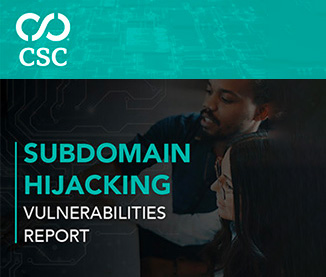

Brand Protection |
Sponsored by |

|



 The lexical material from which trademarks are formed is drawn from the same social and cultural resources available to everyone else, which includes domain name registrants. Since trademarks are essentially a form of communication, it is unsurprising that a good number of them are composed of common terms (dictionary words, descriptive phrases, and shared expressions) that others may lawfully use for their own purposes.
The lexical material from which trademarks are formed is drawn from the same social and cultural resources available to everyone else, which includes domain name registrants. Since trademarks are essentially a form of communication, it is unsurprising that a good number of them are composed of common terms (dictionary words, descriptive phrases, and shared expressions) that others may lawfully use for their own purposes.
 The Uniform Rapid Suspension System (URS) -- which allows a trademark owner to suspend certain domain names, especially those in the "new" gTLDs -- was designed as a quicker and less-expensive alternative to the Uniform Domain Name Dispute Resolution Policy (UDRP). As I've written frequently before, there are significant differences between the URS and the UDRP. One of those differences is how long a typical proceeding lasts.
The Uniform Rapid Suspension System (URS) -- which allows a trademark owner to suspend certain domain names, especially those in the "new" gTLDs -- was designed as a quicker and less-expensive alternative to the Uniform Domain Name Dispute Resolution Policy (UDRP). As I've written frequently before, there are significant differences between the URS and the UDRP. One of those differences is how long a typical proceeding lasts.
 ICANN's WDPRS system has been defeated. The system is intended to remove or correct fraudulently registered domains, but it does not work anymore. Yesterday I submitted a memo to the leadership of the ICANN At-Large Advisory Committee (ALAC) and the greater At-Large community. The memo concerns the details of a 214-day saga of complaints about a single domain used for trafficking opioids.
ICANN's WDPRS system has been defeated. The system is intended to remove or correct fraudulently registered domains, but it does not work anymore. Yesterday I submitted a memo to the leadership of the ICANN At-Large Advisory Committee (ALAC) and the greater At-Large community. The memo concerns the details of a 214-day saga of complaints about a single domain used for trafficking opioids.
 I was on the front lines of the SOPA wars, because SOPA touched on two matters of strong personal and professional importance for me: protecting the Internet infrastructure, and protecting the economy from Internet related crime. I've continued to study this field and advise industry participants in the years since then. The 2017-02-20 paper by Annemarie Bridy entitled Notice and Takedown in the Domain Name System: ICANN's Ambivalent Drift into Online Content Regulation deserves an answer, which I shall attempt here.
I was on the front lines of the SOPA wars, because SOPA touched on two matters of strong personal and professional importance for me: protecting the Internet infrastructure, and protecting the economy from Internet related crime. I've continued to study this field and advise industry participants in the years since then. The 2017-02-20 paper by Annemarie Bridy entitled Notice and Takedown in the Domain Name System: ICANN's Ambivalent Drift into Online Content Regulation deserves an answer, which I shall attempt here.
 As I've written before, domain name disputes involving multiple trademarks sometimes raise interesting issues, including whether a panel can order a domain name transferred to one entity without consent of the other. While panels typically have found ways to resolve this issue, one particularly troubling fact pattern arises when a panel denies a complaint simply because a disputed domain name contains trademarks owned by two different entities.
As I've written before, domain name disputes involving multiple trademarks sometimes raise interesting issues, including whether a panel can order a domain name transferred to one entity without consent of the other. While panels typically have found ways to resolve this issue, one particularly troubling fact pattern arises when a panel denies a complaint simply because a disputed domain name contains trademarks owned by two different entities.
 A proposal from the Domain Name Association (DNA) would provide copyright owners with a new tool to fight online infringement -- but the idea is, like other efforts to protect intellectual property rights on the Internet, proving controversial. The proposed Copyright Alternative Dispute Resolution Policy is one of four parts of the DNA's "Healthy Domains Initiative" (HDI).
A proposal from the Domain Name Association (DNA) would provide copyright owners with a new tool to fight online infringement -- but the idea is, like other efforts to protect intellectual property rights on the Internet, proving controversial. The proposed Copyright Alternative Dispute Resolution Policy is one of four parts of the DNA's "Healthy Domains Initiative" (HDI).
 We had high hopes that the Domain Name Association's Healthy Domains Initiative (HDI) wouldn't be just another secretive industry deal between rightsholders and domain name intermediaries. Toward that end, we and other civil society organizations worked in good faith on many fronts to make sure HDI protected Internet users as well. Those efforts seem to have failed.
We had high hopes that the Domain Name Association's Healthy Domains Initiative (HDI) wouldn't be just another secretive industry deal between rightsholders and domain name intermediaries. Toward that end, we and other civil society organizations worked in good faith on many fronts to make sure HDI protected Internet users as well. Those efforts seem to have failed.
 The domain name system is in good health. But it's about to get even better. The Domain Name Association (DNA), the Internet domain industry's trade association, undertook an effort in 2016 it named the Healthy Domains Initiative (HDI). It's an ambitious, self-motivated effort to build on the DNS' already secure and stable platform and meet select challenges head-on, before they develop.
The domain name system is in good health. But it's about to get even better. The Domain Name Association (DNA), the Internet domain industry's trade association, undertook an effort in 2016 it named the Healthy Domains Initiative (HDI). It's an ambitious, self-motivated effort to build on the DNS' already secure and stable platform and meet select challenges head-on, before they develop.
 Domain names may be confusingly similar to trademarks or even identical or but not infringing. This is particularly true of trademarks acquired later than the allegedly infringing domain names ArcBest Corporation v. Domains By Proxy, LLC, Registration Private / Vernon Troupe, D2016-2381 (WIPO January 13, 2017) (<arcbest.com>, in which "ark" is a contraction of "Arkansas"), but it can also apply to marks composed of common element that predate domain name registration...
Domain names may be confusingly similar to trademarks or even identical or but not infringing. This is particularly true of trademarks acquired later than the allegedly infringing domain names ArcBest Corporation v. Domains By Proxy, LLC, Registration Private / Vernon Troupe, D2016-2381 (WIPO January 13, 2017) (<arcbest.com>, in which "ark" is a contraction of "Arkansas"), but it can also apply to marks composed of common element that predate domain name registration...
 I firmly believe that we need to protect any form of intellectual properties (IP) built by one through hard and honest work. At the same time, I also believe that several of the current methods of protecting IP, such the as the copyright laws, patent systems and legislations, are not evolving fast enough in order to protect IP and avoid hindering the path of creativity and innovation.
I firmly believe that we need to protect any form of intellectual properties (IP) built by one through hard and honest work. At the same time, I also believe that several of the current methods of protecting IP, such the as the copyright laws, patent systems and legislations, are not evolving fast enough in order to protect IP and avoid hindering the path of creativity and innovation.